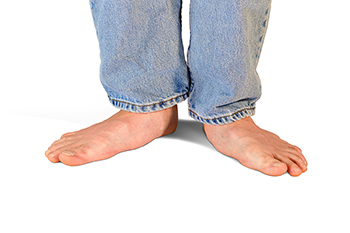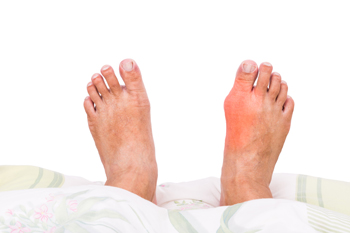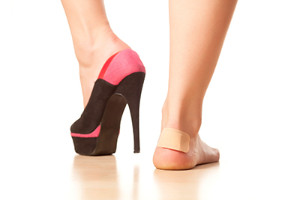Items filtered by date: May 2023
Are You Suffering From Ingrown Toenails?
Running Shoe Options for Flat-Footed People

People with flat feet who enjoy running may experience challenges in finding the right running shoe. There are several factors to consider when deciding which type of shoe to purchase. These can consist of the gait cycle, the individual foot, and the range of motion. Some people have collapsed arches that can cause their feet to become flat due to muscle weakness. Patients with flat feet may opt for a shoe that has additional arch support to help the foot regain strength. Adults who have anatomically flat feet may choose a shoe without arch support, which may help to protect the knees. Research has shown that many flat-footed runners may feel better when stability shoes are worn, even though they may not help to correct the foot structure. Wearing a full-contact midsole shoe may help to protect the entire foot while running, therefore, these shoes are a popular choice among people who have flat feet. If you have flat feet and would like more information about what type of running shoes to purchase, it is suggested that you confer with a podiatrist who can guide you toward the best choice.
Flatfoot is a condition many people suffer from. If you have flat feet, contact Edward S. Pozarny DPM from Arlington Podiatry Center. Our doctor will treat your foot and ankle needs.
What Are Flat Feet?
Flatfoot is a condition in which the arch of the foot is depressed and the sole of the foot is almost completely in contact with the ground. About 20-30% of the population generally has flat feet because their arches never formed during growth.
Conditions & Problems:
Having flat feet makes it difficult to run or walk because of the stress placed on the ankles.
Alignment – The general alignment of your legs can be disrupted, because the ankles move inward which can cause major discomfort.
Knees – If you have complications with your knees, flat feet can be a contributor to arthritis in that area.
Symptoms
- Pain around the heel or arch area
- Trouble standing on the tip toe
- Swelling around the inside of the ankle
- Flat look to one or both feet
- Having your shoes feel uneven when worn
Treatment
If you are experiencing pain and stress on the foot you may weaken the posterior tibial tendon, which runs around the inside of the ankle.
If you have any questions please feel free to contact our office located in Arlington, VA . We offer the newest diagnostic and treatment technologies for all your foot and ankle needs.
How Common Is Increased Foot Size During Pregnancy?

When an individual is pregnant, they might notice that the size of their feet has significantly increased. This is due to the fact that the hormone known as relaxin is released during pregnancy, which can cause the feet to expand and get larger. New mothers often ask how common it is for a woman’s feet to increase during pregnancy. The answer is that 60% of women have seen their feet get longer, and 70% of women have seen their feet get wider. Therefore, it is a relatively common phenomenon. Increasing foot size is just one of many different potential changes that your body might go through during pregnancy. If you are pregnant or planning to be, it is suggested that you contact a podiatrist today for an appointment.
Pregnant women with swollen feet can be treated with a variety of different methods that are readily available. For more information about other cures for swollen feet during pregnancy, consult with Edward S. Pozarny DPM from Arlington Podiatry Center. Our doctor will attend to all of your foot and ankle needs.
What Foot Problems Can Arise During Pregnancy?
One problem that can occur is overpronation, which occurs when the arch of the foot flattens and tends to roll inward. This can cause pain and discomfort in your heels while you’re walking or even just standing up, trying to support your baby.
Another problem is edema, or swelling in the extremities. This often affects the feet during pregnancy but tends to occur in the later stages.
How Can I Keep My Feet Healthy During Pregnancy?
- Wearing orthotics can provide extra support for the feet and help distribute weight evenly
- Minimize the amount of time spent walking barefoot
- Wear shoes with good arch support
- Wear shoes that allow for good circulation to the feet
- Elevate feet if you experience swelling
- Massage your feet
- Get regular, light exercise, such as walking, to promote blood circulation to the feet
If you have any questions please feel free to contact our office located in Arlington, VA . We offer the newest diagnostic and treatment technologies for all your foot and ankle needs.
Foot Problems That Mimic Bunions

People with a big toe joint problem often assume it is from a bunion. However, other things can look like a bunion but are entirely different. Bunions are bony bumps that form on the sides of big toes. They result from a misalignment of the big toe joint and are not bone growths. Arthritis affecting the big toe joint can look like a bunion because a bone spur can develop on the joint. The skin on the bone spur can be inflamed and red, resembling a bunion. These bone spurs often occur on the top of the big toe joint rather than on the side of the joint. A ganglion cyst is a firm, fluid-filled sac that can occur on the big toe joint and be mistaken for a bunion, but is softer to the touch. Gout is yet another affliction that can affect the big toe joint and cause symptoms of redness and swelling, looking like a bunion. If you notice something different about your big toe joint and wonder if it is a bunion, it is suggested that you visit a podiatrist to get a proper diagnosis and treatment.
If you are suffering from bunion pain, contact Edward S. Pozarny DPM of Arlington Podiatry Center. Our doctor can provide the care you need to keep you pain-free and on your feet.
What Is a Bunion?
Bunions are painful bony bumps that usually develop on the inside of the foot at the joint of the big toe. As the deformity increases over time, it may become painful to walk and wear shoes. Women are more likely to exacerbate existing bunions since they often wear tight, narrow shoes that shift their toes together. Bunion pain can be relieved by wearing wider shoes with enough room for the toes.
Causes
- Genetics – some people inherit feet that are more prone to bunion development
- Inflammatory Conditions - rheumatoid arthritis and polio may cause bunion development
Symptoms
- Redness and inflammation
- Pain and tenderness
- Callus or corns on the bump
- Restricted motion in the big toe
In order to diagnose your bunion, your podiatrist may ask about your medical history, symptoms, and general health. Your doctor might also order an x-ray to take a closer look at your feet. Nonsurgical treatment options include orthotics, padding, icing, changes in footwear, and medication. If nonsurgical treatments don’t alleviate your bunion pain, surgery may be necessary.
If you have any questions, please feel free to contact our office located in Arlington, VA . We offer the newest diagnostic and treatment technologies for all your foot care needs.
What Causes the Ankle to Lock?

The ankle is a complex and hard-working joint that bears multiple times the weight of your body with each step. It also is tasked with swiveling and flexing in three directions, a combined effort of the talus bone in the ankle and the tibia bone in the leg. Sometimes an ankle sprain or other condition will stop the joint from doing its work, and the ankle joint seems to lock up. This might be the result of a chip of bone or fragment of cartilage that is caught between the two bones. It can feel like gravel is in the ankle joint, and it is common among younger athletes. In other cases, diminished blood flow to the joint may result in the cartilage drying out, which affects the motion of the joint. Symptoms include prolonged ankle pain, swelling, and instability of the ankle joint. If you are experiencing this type of ankle pain, it is suggested that you make an appointment with a podiatrist.
Ankle pain can be caused by a number of problems and may be potentially serious. If you have ankle pain, consult with Edward S. Pozarny DPM from Arlington Podiatry Center. Our doctor will assess your condition and provide you with quality foot and ankle treatment.
Ankle pain is any condition that causes pain in the ankle. Due to the fact that the ankle consists of tendons, muscles, bones, and ligaments, ankle pain can come from a number of different conditions.
Causes
The most common causes of ankle pain include:
- Types of arthritis (rheumatoid, osteoarthritis, and gout)
- Ankle sprains
- Broken ankles
- Achilles tendinitis
- Achilles tendon rupture
- Stress fractures
- Bursitis
- Tarsal tunnel syndrome
- Plantar fasciitis
Symptoms
Symptoms of ankle injury vary based upon the condition. Pain may include general pain and discomfort, swelling, aching, redness, bruising, burning or stabbing sensations, and/or loss of sensation.
Diagnosis
Due to the wide variety of potential causes of ankle pain, podiatrists will utilize a number of different methods to properly diagnose ankle pain. This can include asking for personal and family medical histories and of any recent injuries. Further diagnosis may include sensation tests, a physical examination, and potentially x-rays or other imaging tests.
Treatment
Just as the range of causes varies widely, so do treatments. Some more common treatments are rest, ice packs, keeping pressure off the foot, orthotics and braces, medication for inflammation and pain, and surgery.
If you have any questions, please feel free to contact our office located in Arlington, VA . We offer the newest diagnostic and treatment technologies for all your foot care needs.
Wearing High Heels May Be Detrimental to Foot Health

Many people endure the pain that can come from wearing high heels. This can be a result of the foot being forced into this type of shoe, and ending up in an unnatural position. This can cause the toes to push together as the heel extends up. Many women have discomfort from wearing high heels after approximately an hour, and may tend to ignore the pain. Wearing high heels can add sleekness to the leg, and the body can appear to be thinner and taller. Despite these favorable qualities, research has indicated that frequently wearing high heels may change the muscle balance surrounding the ankle joint, possibly leading to instability. High heels can push the center of gravity in the body up and forward, and changes to the posture may be needed to help maintain proper balance. If you would like additional information about the pros and cons of wearing high heels, it is suggested that you confer with a podiatrist who can help you in determining if wearing high heels is right for you.
High heels have a history of causing foot and ankle problems. If you have any concerns about your feet or ankles, contact Edward S. Pozarny DPM from Arlington Podiatry Center. Our doctor can provide the care you need to keep you pain-free and on your feet.
Effects of High Heels on the Feet
High heels are popular shoes among women because of their many styles and societal appeal. Despite this, high heels can still cause many health problems if worn too frequently.
Which Parts of My Body Will Be Affected by High Heels?
- Ankle Joints
- Achilles Tendon – May shorten and stiffen with prolonged wear
- Balls of the Feet
- Knees – Heels cause the knees to bend constantly, creating stress on them
- Back – They decrease the spine’s ability to absorb shock, which may lead to back pain. The vertebrae of the lower back may compress.
What Kinds of Foot Problems Can Develop from Wearing High Heels?
- Corns
- Calluses
- Hammertoe
- Bunions
- Morton’s Neuroma
- Plantar Fasciitis
How Can I Still Wear High Heels and Maintain Foot Health?
If you want to wear high heeled shoes, make sure that you are not wearing them every day, as this will help prevent long term physical problems. Try wearing thicker heels as opposed to stilettos to distribute weight more evenly across the feet. Always make sure you are wearing the proper shoes for the right occasion, such as sneakers for exercising. If you walk to work, try carrying your heels with you and changing into them once you arrive at work. Adding inserts to your heels can help cushion your feet and absorb shock. Full foot inserts or metatarsal pads are available.
If you have any questions please feel free to contact our office located in Arlington, VA . We offer the newest diagnostic and treatment technologies for all your foot and ankle needs.

